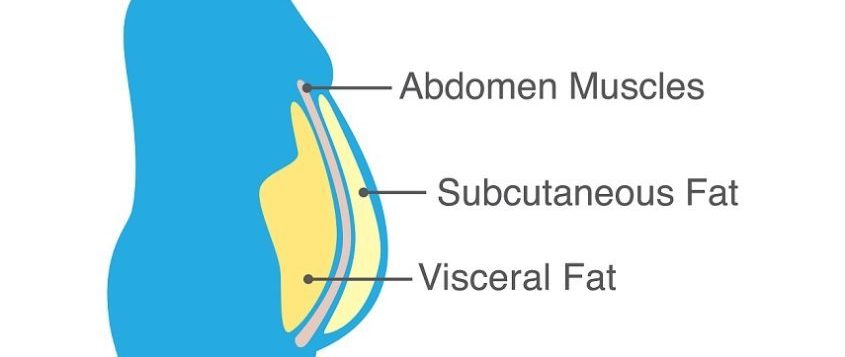The effects of visceral fat are probably not something most people think about. They are much more likely to think about belly fat in general with the goal of getting rid of it as quickly as possible.
If you have problems with belly fat, you can probably identify with this attitude. Studies show a high percentage of people are unhappy with the appearance of their bellies. Most of them want to get rid of their belly fat for aesthetic reasons, but did you know there is a type of belly fat that is not only unhealthy but deadly?
It’s true.
The effects of visceral fat on your health is so much worse than any cosmetic complication, and most people don’t even know they’re in danger.
The Effects of Visceral Fat Vs. Subcutaneous Fat
There was a time when fat (adipose tissue) was simply considered an inert tissue that stores fat. We now know fat is metabolically active tissue that synthesizes and secretes hormones. Fat tissue plays a role in insulin sensitivity, inflammatory process mediation, and more.
This is why the effects of visceral fat on health and those of subcutaneous fat are as different as night and day. Let’s start with subcutaneous fat.
Subcutaneous fat is the layer of fat that lies just beneath the skin. It is the fat you can pinch beneath your fingers, the fat that jiggles and dimples, and it is distributed throughout your entire body. Wherever you have skin, you have a layer of subcutaneous fat beneath it. Evidence suggests subcutaneous fat may actually be good for your health. Research shows subcutaneous fat may improve glucose metabolism for better blood sugar control.
Visceral fat lies deep within the abdominal cavity, surrounding and at times even wrapping around vital organs, such as the kidneys, pancreas, and liver. You cannot see or feel visceral fat. But the effects of visceral fat located so close to these organs increase the risk for many serious health conditions.
Researchers have learned that visceral fat pumps immune system and inflammatory chemicals, which they believe probably enters the nearby portal vein of the intestine. These chemicals are then carried to the liver and cause cardiovascular disease, insulin resistance, and other serious conditions.
The Effects of Visceral Fat on Body Shape: How to Tell by Appearance
Though you cannot see visceral fat, there are a few ways that appearance can indicate the likely presence of visceral fat.
The best way to see the effects of visceral fat on body shape is to look at yourself in a full-length mirror. Are you pear shaped or apple shaped? You see, if most of your fat is in the lower half of your body (your butt, thighs, etc.), you have a pear-shaped body, and your fat is likely to be subcutaneous.
If most of your fat is in the upper part of your body, the abdominal area, you are likely to have a large amount of visceral fat.
Looking in the mirror is not the only way to know if you might have visceral fat. You can also simply measure the circumference of your waist. If your waist circumference is 35 or more inches if a woman, or 40 or more inches if a man, you likely have a high level of visceral fat.
If you want to be absolutely sure you have visceral fat, you can schedule an MRI with your healthcare provider. Though an MRI is expensive, it will give you a visual look at the amount of visceral fat surrounding your organs.
Skinny Fat: One of the Effects of Visceral Fat that is Invisible
Having a large waist circumference is not always the best way to judge the effects of visceral fat on the body. There was a time when everybody judged one’s health and their risk for health problems based on their level of obvious body fat. In other words, a heavy person was thought to be automatically unhealthy, and a thin person was automatically thought to be healthy.
We now know that this isn’t true. In recent years, the concept of metabolically obese normal weight people came into view. Also known as “skinny fat,” these individuals have too much body fat and not enough muscle. Though they may have a slight pouch to their belly, it is usually not that noticeable. To all appearances, they look thin and healthy.
But underneath this appearance, they have high levels of visceral fat subjecting them to all the potential health problems of an obese individual. This means that thousands of seemingly thin and healthy people are being diagnosed with high cholesterol, high blood pressure, type 2 diabetes. They may also have cardiovascular disease and strokes.
Being skinny fat is worse than being overweight or obese because those who are thin are typically not screened for obesity-related diseases. After all, their body mass index is normal. Why would doctors worry about them?
The Effects of Visceral Fat on Health
The effects of visceral fat on health are many. Having an excess amount of visceral fat increases your risk for many serious conditions, including:
- Diabetes
- Heart Disease
- Abnormal Cholesterol Levels
- High Blood Pressure
- Dementia
- Stroke
- Depression
- Sexual Dysfunction
- Breast Cancer
- Colorectal Cancer
- Metabolic Syndrome
Causes of Visceral Fat
Though there is a genetic component of visceral fat, the biggest causes of this condition are poor-quality diet and inactivity. Your body is an amazingly complex machine. It knows exactly what to do to keep you healthy, and it knows what to do to heal your body.
The body can handle a large quantity of food with no problem. What it cannot handle are aggressive calories.
You see, not all calories are the same when it comes to being stored as body fat. When you eat, a digestive traffic cop tells calories where to go. How aggressively calories approach this cop determines whether they will be stored as visceral fat or subcutaneous fat.
This digestive traffic cop directs calories to repair, fuel, or fatten us, making sure we have all the nutrients we need to repair our body, give us energy, and keep us from starving. If you have a calm, consistent flow of calories coming into your system, the cop does a great job directing these calories to the places they will do the most good.
But if the digestive cop has to deal with a bunch of aggressive requests all at once, he or she just throws them in the fat cells. For example, when you consume refined carbohydrates and sugars, your body breaks them down into simple sugars (glucose), and then sends it to your bloodstream. Because refined carbs and sugars contain no fiber to slow digestion down, the glucose is absorbed quickly into the bloodstream, and your blood glucose levels rise.
Whenever you eat foods that rapidly increase levels of glucose in your bloodstream (called aggressive calories), your body is likely to store the excess glucose as fat. That’s because your body can only deal with a certain amount of glucose at one time. According to researchers, the body has only around 40 calories of glucose circulating in the bloodstream at a time. Anything that exceeds that amount has to be rapidly cleared from the bloodstream to keep blood sugar levels normal, which means that most of it ends up in the fat cells.
The same effect does not happen if you eat a lot of non-aggressive calories, such as non-starchy vegetables or protein, that gradually enter the bloodstream over several hours. Your digestive traffic cop can deal with them, and the effects of visceral fat will not apply.
5 Healthy Ways to Eliminate the Effects of Visceral Fat in Your Life
There are several ways to eliminate the effects of visceral fat in your life. Here are 6 of the best ways.
Reduce Refined Sugar and Refined Carbohydrate Consumption
One of the best ways to eliminate the effects of visceral fat is to reduce refined sugar and refined carbohydrate consumption. Studies have shown that both may lead to increased visceral fat accumulation.
Refined sugars are processed sugar added to foods. Refined carbs are foods that contain no fiber or nutrients. They are “empty” calories that cause surges in your blood sugar levels that promote visceral fat storage. (Refined carbs include white flour, white bread, white rice, breakfast cereals, sodas, and pastas.)
Limit Ultra-Processed Foods
Ultra-processed foods are chemical concoctions made to look, smell, and taste like real foods. They are food-like products that contain no fiber and few nutrients. Because of their lack of fiber, they are digested quickly, causing a rapid rise in blood glucose levels.
A recent study showed more than half of the average American’s calories are composed of ultra-processed foods, which probably explains why the rates of overweight and obesity — along with the levels of visceral fat — are so high.
NON-STARCHY VEGETABLES
10+ servings per day
The fiber in non-starchy vegetables slows their absorption into the bloodstream, stabilizing blood sugar levels. They also contain high amounts of vitamins, minerals, and other nutrients that nourish your cells.
Here are some examples of great non-starchy vegetables to add to your plate:
- Asparagus
- Broccoli
- Eggplant
- Kale
- Onions
- Spinach
NUTRIENT-DENSE PROTEINS
3-5 servings per day, 30-55 grams per meal
Nutrient-dense proteins take a long time to digest, meaning they cause a slow rise in blood sugar levels.
Here are some delicious nutrient-dense proteins to try today:
- Chicken
- Cottage Cheese
- Egg Whites
- Grass-Fed Beef
- Nonfat Greek Yogurt
- Salmon
WHOLE-FOOD FATS
3-6 servings per day
Whole-food fats are satisfying, and like non-starchy vegetables and nutrient-dense proteins, whole-food fats help regulate your blood sugar levels. Plus, if you replace refined carbs and sugars with whole-food fats, your body will start burning your fat stores — and that includes your visceral fat stores!
LOW-FRUCTOSE FRUITS
0-3 servings per day
Enjoy a serving of low-fructose fruit as a between-meal snack or after dinner.
Here are some tasty choices:
- Blueberries
- Lemons
- Grapefruit
- Oranges
- Peaches
- Strawberries
Reduce Stress
Studies show chronic stress increases belly fat, particularly visceral fat. That’s because stress causes increased levels of cortisol, which also cause a release of insulin, a hormone that promotes fat storage.
The best way to counteract cortisol and insulin is to make it a point to regularly de-stress. Here are a few ideas to get you started.
- Meditate
- Take a walk in the park
- Pet your dog. (Studies show pets have a calming effect on their owners.)
- Go out to dinner with friends.
- Watch a marathon of your favorite sitcom. (Studies show laughter really IS the best medicine!)
- Take up a hobby
- Practice deep breathing exercises
- Do a good deed for someone. (Studies show doing something good for someone else raises the level of “feel good” hormones for the doer.)
- Listen to soothing music.
- Soak in a warm bubble bath.
Get Enough Sleep
Sleep deprivation has been linked to an increase of belly fat, and that increased visceral fat. Cortisol also plays a role here, but studies show there are other hormones involved that increase hunger and encourage fat storage when we are sleep deprived.
To avoid the effects of visceral fat, it is imperative you get enough quality sleep. Here are some easy tips to help you do that.
- Turn off the television, computer, and smartphone 1 hour before bedtime. The light from the screen interferes with melatonin production, making your brain think it’s time to be up and active when it’s really time for bed.
- Keep your room dark, allowing no light in, if possible. If necessary, wear a sleep mask. (Any light can interfere with melatonin production.)
- Go to bed at the same time every night. Doing so will train your body to get tired at a particular time each night.
- Drink a cup of soothing, relaxing chamomile tea before bedtime.
- Avoid sleeping in — even on weekend. It is important to stay on a set sleep schedule to be able to consistently achieve a good night’s sleep.










